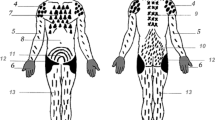Summary
We compared pain measured by the 17-item Short Pain Inventory© in two samples of dental patients with two medical samples and with two non-patient samples. We contrasted all six samples to pilot the use of the inventory as an aid to clinicians in the evaluation of pain experienced by dental and medical patients. Six parallel groups of patients (n=266) were contrasted on pain severity, total mood disturbance and subscales of pain induced mood disturbance. The ability to discriminate between different patient groups and between pain—non-pain, indexed validity. Test-retest reliability and internal reliability were also computed.
Patients attending the King’s emergency dental clinic showed the highest pain disturbance compared with all other groups. The order of magnitude of pain disturbance thereafter was in the general order of Chronic Pain Clinic > Beckton General Dental Practice > Osteoarthritic knee outpatients > stressed teachers and normal healthy non-patients. The SPI was successful at revealing significant differences in pain severity and pain-related mood disturbance, relating to the global well being of the patient. Significant group differences were also seen in pain-induced anger, sadness, sedation, anxiety and social interaction. We conclude that the SPI gives valuable, reliable and valid pain information. It may helpful in the management of dental and medical patients and in future clinical trials.























Similar content being viewed by others
References
Carman A, Friedman Y, Coger R, et al. Single trial analysis of evoked potentials to noxious thermal stimulation in man. Pain 1980; 8:21–32.
Kilminster SG and Jones DM. Perceived control and the cold pressor test. Stress Med 1986; 2:73–77.
Murphy JK, Sperr EV and Sperr SJ. Chronic pain: An investigation of assessment instruments. J Psychosom. Res. 1986; 30:289–296.
Kilminster SG, Sutton JA, Dunstan D and Mould GP. A new model of laser induced pain differentiates between onset times of analgesia from liquid and capsule formulations of a codeine-paracetamol combination. Eur J Clin. Res. 1997; 9:283–291.
Jones SF, McQuay HJ, Moore RA, et al.. Morphine and ibruprofen compared using the cold pressor test. Pain 1988; 9:3–12.
Oppenheim A N. Questionnaire Design and Attitude Measurement. Heinmann 1968.
Likert R. A technique for the measurement of attitudes. Arch Psychology. 1932: Number 140.
Twycross R. Symptom management in advanced cancer. Oxford: Radcliffe Medical Press 1997, p. 257.
Torrejon VA. Treatment of severe rheumatic pain with accelofenac verus placebo. Acta Therap 1988; 14:275–280.
Torri G, Vignati C, Agrifoglio E, et al. Aceclofenac versus piroxicam in the management of osteoarthritis of the knee: a double blind controlled study. Curr Ther Res Clin Exp. 1994; 55:576–583.
Lequesne M, Mery C, Sampson M and Gerard P. Indexes of severity for osteoarthritis of the hip and knee. Validation value in comparing with other assessment tests. Scand J Rheumatol. 1987; 16(Suppl 65):85–89.
Ward DE, Veys EM, Bowdler JM and Roma J. Comparison of aceclofenac with diclofenac in the treatment of osteoarthritis. Clinl Rheumatol. 1995; 14:656–662.
la SernaDiaz C, Rodriguez de A, Geli C, et al. Efficacy and tolerability of aceclofenac versus diclofenac in the treatment of knee osteoarthritis: a multicentre study. Eur J Rheumatol Inflamm 1996; 16:17–22.
Statistica. Statistical Manual I–III. Statsoft. Tulsa. OK. USA. 1994.
Kerlinger F N. Foundations of Behavioural Research. Holt Rinehart and Winston. 1973.
Hayes W L. Statistics. Holt Rinehart and Winston. 1988.
Chapman C R and Syrjala K L. Measurement of pain: In Bonica JJ (Ed). The management of pain. Philadelphia: Lea and Febiger. 1990. pp. 580–594.
ABPI. Compendium of data sheets and summaries of product characteristics. 1998-1999. Datapharm Publications. 1200–1202
Melzack R. The McGill pain Questionnaire: Major properties and scoring methods. Pain 1975; 1:277–291.
Spielberger C D. Gorsuch R and Lushene RE. STAI manual. 1974. Consulting Psychologists Press. California. USA.
McNair D M. Lorr M. Droppleman. Profile of mood states. 1971. San Diego: Educational and industrial testing service.
Ahmedzai S and Brooks D. Transdermal fentanyl versus sustained release oral morphine in cancer pain: efficacy and quality of life. J Pain Symptom Management 1997; 13 (5):254–61.
Kilminster SG and Mould GP. Comparison of diclofenac spray and gel on knee joints of patients with osteoarthritic pain. Clin Drug Invest 1999; 18:345–354.
Kilminster S G. Manual for the Short Pain Inventory (1998). Lawrencian Clinical Publications and Selsey Press Ltd. West Sussex.
Sternbach RA. Survey of pain in the United States: The Nuprin Pain Report. Clin J Pain 1986; 2:49–53.
Kerr NW. Dental pain and suffering prior to the advent of modern dentistry. Br Dent J 1998; 184 (8):397–399.
Holmes C. An analysis of patients attending two emergency dental clinics in Edinburgh. Health Bull (Edinburgh). 1995; 53(1):73–83.
Gibson GB, Blasberg B and Hill SJ. A prospective study of hospital ambulatory dental emergencies. Part 1: Patient and emergency characteristics. Spec Care Dentist. 1993; 13(2):61–65.
Wall P D and Melzack R. Textbook of Pain. London: Churchill Livingstone. 1994.
Author information
Authors and Affiliations
Rights and permissions
About this article
Cite this article
Kilminster, S.G., Power, M.W.H. & Fozardz, J.R. Survey of pain in two medical and dental clinics with non-patient controls using the Short Pain Inventory©. International Journal of Pharmaceutical Medicine 14, 137–147 (2000). https://doi.org/10.1097/00124363-200006000-00007
Published:
Issue Date:
DOI: https://doi.org/10.1097/00124363-200006000-00007




